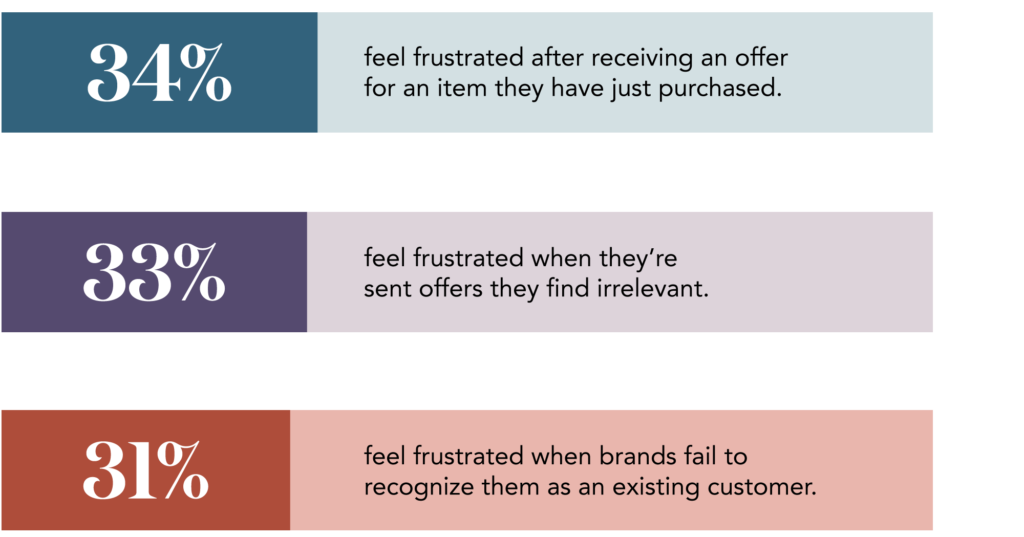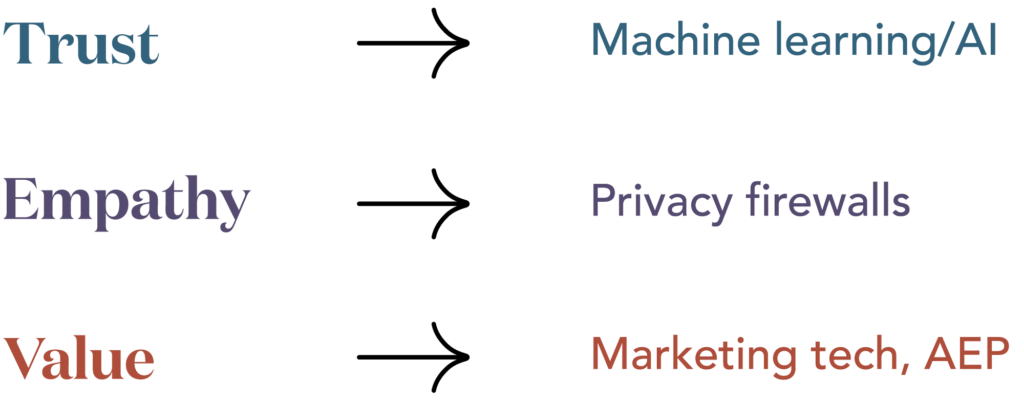Remember the days when getting your hands on anonymous data from shopper loyalty cards was considered revolutionary?
Over the last decade, marketers refined their strategy, becoming hyperfocused on account-based marketing (ABM) and genuine “personalization” of audiences.
This evolution of personalization across B2B and B2C initially started with handcrafted campaigns, eventually leading to mass campaigns, customizations, and now sophisticated omnichannel experiences. And over the years, as marketers delivered these personalized experiences, naturally, consumer expectations rose—leading to 63% of consumers now expecting a personalized interaction with a brand or service (Source: The Harris Poll).
Yet, that same survey revealed the ugly truth that brands are failing to deliver valued experiences: 34% feel frustrated after receiving an offer for an item they have just purchased, 33% are frustrated when they’re sent offers they find irrelevant, and 31% find it frustrating when brands fail to recognize them as an existing customer.

People should be annoyed. They’re giving marketers data and expecting a stellar customer experience in return.
To bridge this gap, the solution is quite simple: Add the layer of a human reframe by first identifying the Truth (the customer or account’s reality) and then craft a moment of Beauty (a brand’s response).
Whoever your audience is, B2B and B2C marketers should always approach people the way they normally would if they were face-to-face, and then leverage data and tech to scale the experience. Humans are naturally great at personalization—we just need to translate this into our technology.
So how can you scale 1:1 human connections with tech? Start by identifying the three key elements of a genuine 1:1 human connection:
- Empathy: Being able to understand and share the feelings of another person. As a marketer, it’s incredibly important to understand what the consumer is going through, their needs, challenges, etc. Beyond that, it’s the ability to respond to verbal and nonverbal cues and know when to push, when to back off, and what to say at the appropriate time.
- Trust: Trust is the bedrock of a human relationship. The other person needs to feel (and know) that they can trust you with the intimate information they share, knowing that you will not misuse it.
- Value: Ultimately, a relationship is successful in the long term if both parties gain value from it. Value does not always mean monetary value. It could be anything from learning something new to coming away enriched by an experience or experiencing personal growth. In an ABM scenario, for example, this translates to responding to customer needs as they work through the buying process, and providing them what they need (education, support, etc.) rather than just focusing on closing the sale. Adobe’s Progress in personalization speaks to the rising demand of personalization.
But how do we incorporate elements of empathy, trust, and value in our marketing efforts so that we can scale up our communication and talk to not one but thousands, or even millions, of customers simultaneously—and with technology, of course?

The best solution for your brand is ultimately customizing to your business, and there are three major categories:
- Machine learning/artificial intelligence (AI) to gain empathy: Rapid strides have been made in AI where machines have developed the ability to show a basic level of empathy. While a lot still needs to be done, it’s certainly a good start. Companies are now able to read human expressions to decipher basic human emotional states. And Alexa, that ever-present AI assistant, is now able to express its own excitement (or disappointment) through its tone of voice. The ability of machines to now convey a basic sense of empathy broadens the scope for them to solve more than just basic consumer issues. It allows them to take on more of the connections from humans, who can then focus on much more nuanced decisions involving a much higher degree of empathy than what machines can produce today.
- Privacy firewalls to gain trust: Privacy today is a hot topic, and rightfully so. With mountains of personal customer data available at the click of a button, keeping it all safe is a challenge. Another challenge is to make sure it is appropriately used, with the right permissions in accordance with the wishes of the consumers who generated it. Confounding the problem is the rapidly changing legal and regulatory landscape, which is adding layers upon layers of “if-then” statements to using customer data, with a view to protecting privacy. Using machines to scale this level of privacy protection is not an option but a requirement. Today platforms feature built-in data governance safeguards that can be configured to account for both the changing laws as well as the privacy bounds of the organization itself. This is something that is downright impossible for a human to do at any reasonable scale, but something that machines can handle with ease.
- Marketing tech to drive value: There must be a seamless platform to bring together the ability to deeply understand consumers, build deep consumer journeys, understand their motivations, and deliver messages of purpose in the channels they prefer. “Remove the clutter and deliver them something they will find of value” is much easier said than done. But marketing technology stacks help accomplish just that. Our partners at Adobe get it and are creating tools that allow us to deliver. The Adobe Experience Platform (AEP) has components that solve personalization at scale. The AEP Audience Manager allows marketers to really understand their audience through a combination of behavior and third-party preference data. It also allows marketers to seamlessly connect different tools and the data obtained in a centralized location, which is then enriched through the application of AI via the Sensei platform. Solutions such as Adobe’s AEP are helping brands drive human to human connection to an unprecedented scale.
Bottom Line
As marketers, it’s our responsibility to reframe every client or account problem through a human lens. With the help of tech partners such as Adobe, this once only-human touch can be scaled to reach millions. And that’s where the magic happens.








